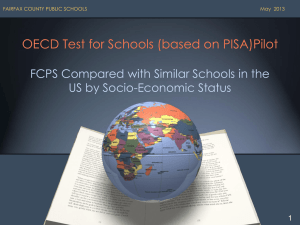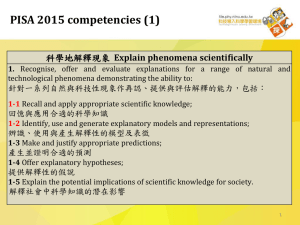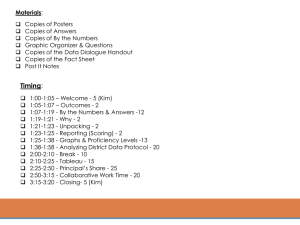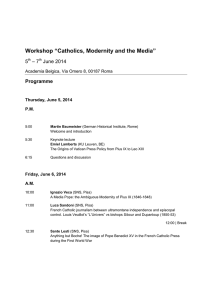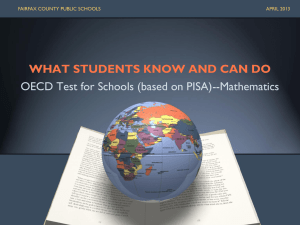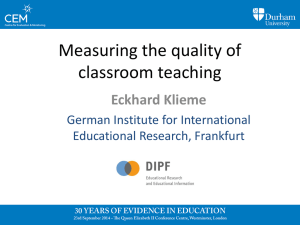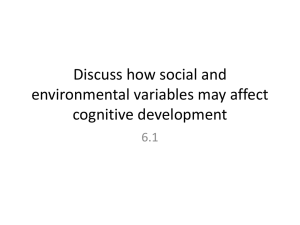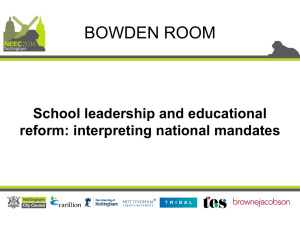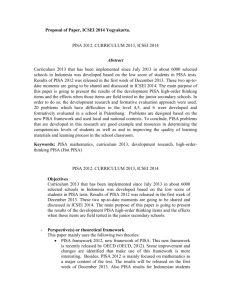what students know and can do - Fairfax County Public Schools
advertisement
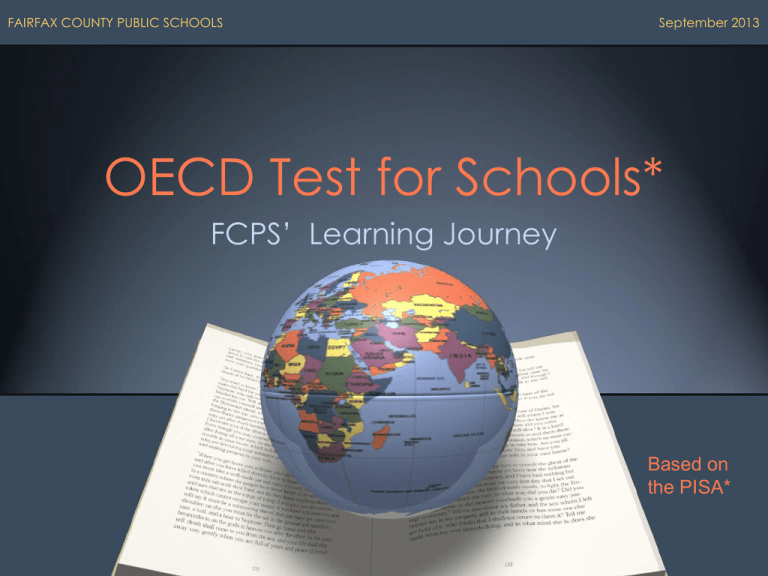
FAIRFAX COUNTY PUBLIC SCHOOLS September 2013 OECD Test for Schools* FCPS’ Learning Journey Based on the PISA* Welcome and Introductions What I know about PISA! Outcomes Gain a greater understanding of the PISA Test Engage in a dialogue concerning the PISA results Show how to locate information online PISA Purpose • Benchmarking in reading, math and science • Results and comparative analysis • Policy analysis It is not: • Mandated or standardized • Not formative • Not aligned to common core or specific curricular standards PISA for Schools Pilot • • • • • • • • 125 Schools in Canada, UK and US 48 School Districts FCPS had 10 schools participate 6 magnets, 6 charters and 1 private school included 7,400 students tested during May and June 2012 75 students per school targeted Reading, Math, and Science are assessed Students also answered a questionnaire about classroom management and relationships with teachers PISA • Students were selected by the testing company, based on their birthday • Students had ~ 3 hours to complete the PISA test for schools, including the questionnaire • Students had to be able to take a paper and pencil test OECD Test for Schools Case Study PISA’s Measure of SES The PISA index of social, cultural and economic status is based on information provided by students about their parents’ education, occupations and wealth (i.e., internet, computers, cars, and bathrooms) Noted on slides as: PISA index of socio-economic background (ESCS) Langley High School Socio-economic advantage of students Langley High School The socio-economic background of students in Fairfax County schools How the mathematics performance of the schools in Fairfax County compare with other schools in the United States on PISA 2009 Mathematics Fairfax County Public Schools (2012) Schools in the United States that participated in PISA 2009 Mean score on the PISA mathematics scale 700 600 600 is the Shanghai Mean 500 487 is the US Mean 400 300 1 -2 -1.5 -1 -0.5 0 Socio-economic background (ESCS) 0.5 1 1.5 2 Mathematics Levels Examples of 4C’s in each level 6 • Students can conceptualize, generalize and utilize information based on their investigations and modeling of complex problems 5 • Students can reflect on their problem solving actions and communicate their interpretations and reasoning 4 • Students can select and integrate different representations, including symbolic ones, linking them directly to the real-world. 3 • Students can write short communications reporting their interpretations, results and reasoning 2 • Students can extract relevant information from a single source 1 • Student can perform actions that are obvious How proficient are students in schools in Fairfax County in mathematics? MATHEMATICS Students at Level 2 or above Students at Level 1 or below Chantilly HS Falls Church HS Hayfield SS Herndon HS Langley HS Lee HS Mount Vernon HS Oakton HS Thomas Jefferson HSST Woodson HS FCPS--Pilot Average US--2009 Shanghai-China--2009 -100 -80 Level1 -60 Below Level 1 -40 Level 2 -20 Level 3 0 20 Level 4 40 Level 5 60 Level 6 80 100 Are You Smarter Than a 15-Year-Old? 11 Reflection • What do you notice about the assessment? • What do students need to know and be able to do? • Were the questions hard or easy for you? • What types of questions were harder? Levels Examples of 4C’s in each level 6 • Students can conceptualize, generalize and utilize information based on their investigations and modeling of complex problems 5 4 3 2 1 • Students can reflect on their problem solving actions and communicate their interpretations and reasoning • Students can select and integrate different representations, including symbolic ones, linking them directly to the real-world. • Students can write short communications reporting their interpretations, results and reasoning • Students can extract relevant information from a single source • Student can perform actions that are obvious Students’ Self-efficacy in Mathematics • Self-efficacy in mathematics: Students’ self-belief in their ability to overcome difficulties or obstacles to solving math problems • Confidence that one will be able to solve a problem is a precursor to investing the time and effort needed to tackle it Oakton Teacher Student-Relations Other Data Available • International and national comparisons • Learning Environment and Teacher-Student Relationship • Students’ reading habits • Students’ attitudes about reading, math and science • Student’s self-beliefs and interest in reading and science • Public and private school comparisons • Boys and girls comparison in reading, math, and science • Extensive research information Next Steps for FCPS • Participate in 2013 -14 • Network with other schools in the US that participated in the PISA pilot – America Achieves Event – EdLeader21 • Share the results with all FCPS schools – Pyramid Planning – Benchmarking against the best – Leadership Conference- Pasi Sahlberg – Division Strengths/Challenges • Examine FCPS/VA/US policies to ensure they are supportive of the best conditions for learning Final Thoughts What does this mean for parents? Want to know more? http://www.fcps.edu/pla/ost/_pisa/pisa_index.shtml
